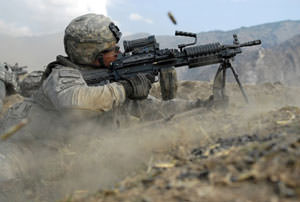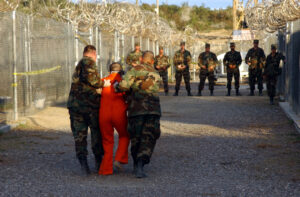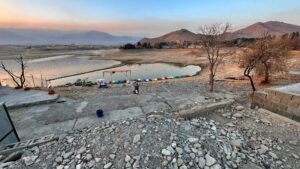Getting Out of Afghanistan With Grace
The best way to deal with an insurrection is not to go in the first place. The second-best way is to get out as quickly and gracefully as possible.There are two proven ways to handle insurgency in non-Western countries: (1) Don't invade. (2) Get out.
There are two tried and disproved methods for dealing with insurrection in a non-Western country. The third and reliable method is not to go there in the first place. The fourth is get out with such grace as is possible, as rapidly as possible. President Barack Obama may be looking at the last option, hitherto not on the policy menu.
The first method is treat the insurrection as a conventional military challenge. Attack en masse to destroy the uprising and its infrastructure, employ shock-and-awe tactics, search for and destroy the rebels’ sources of supply, even when this means invading neighboring countries. Make the enemy stand up and fight the way Americans fight wars. Rely on mass, overwhelming logistical superiority, and the huge American technological advantage.
This was Gen. William Westmoreland’s strategy at the start of the Vietnam War. Outkill the enemy. Make body counts the measure of success. By 1969, this program had failed and Westmoreland had been relieved.
In Iraq, in 2003, the United States again went in with fast, high-powered and overwhelming armed force, blasting to shreds whatever was in its way. It was a great success in getting to Baghdad. But the enemy had not been interested in fighting. Several of the most important Iraqi generals had secretly been bought off. The ordinary soldier had no enthusiasm in fighting for Saddam Hussein, nor had the midlevel officers.
The Iraq army expected to be taken over by the conquerors and put to work cleaning up and re-establishing order in the country. Instead the soldiers were told to go home: that they were untrustworthy Baathists — nationalists, socialists and pan-Arabists — members of Saddam Hussein’s old party. So they went home and found other things to do, such as taking part in an insurrection to drive the occupiers out, not without success.
The Americans have started to leave Iraq, having gained nothing except to make Iran the regional great power, and to create hostility for American oil companies that wanted but are not getting oilfield development contracts.
Iraq is still a very unsettled country, with a difficult national election scheduled at the beginning of the new year. American troops are supposed to leave the country in two years, but doubt about that remains. Mideastern, Turkish, European, Russian and Far Eastern companies are highly actively looking for business there. (The U.S. State Department advises American businessmen against traveling to Iraq; it’s too dangerous.)
A second classic strategic theory for defeating insurrections is “clear and hold.” This is very much in fashion in Washington now thanks to its advocacy by Gen. David H. Petraeus at Central Command and Stanley A. McChrystal in Afghanistan, and also in two recent books, one by Lewis Sorley, the other by David Kilcullen, both arguing that the Vietnam War was actually won by such a strategy — but too late for the fickle American press, public opinion and Congress to recognize the victory.
Clear and hold means ejecting guerrillas from an area and then protecting it from their return. This began in postwar Malaya (as it was then) in 1948, when an insurrection from inside the Chinese minority population caused much of that population to be confined in guarded villages, leaving British troops free to deal with the Chinese who escaped this treatment. Eventually a political solution was found.
In Vietnam, where the U.S. copied the method, these villages were called Strategic Hamlets and were employed in conjunction with the Phoenix program to “clear” areas of enemy or unreliable elements, and defend against the return of the Viet Cong. The Sorley and Kilcullen books notwithstanding, the Communists won that war, the American part of it having lasted from 1963 to 1973.
In the Afghanistan case, Gen. McChrystal has suggested that his war, if fought on his terms (with troop reinforcements rising to a total of over 100,000 men at least), would take between 10 and 50 years to succeed.
Afghanistan consists of 652,230 square kilometers (251,827 square miles), many of them more or less vertically inclined, populated by an estimated 28.4 million people. Iraq has an estimated population of 28.9 million people and 438,317 square kilometers (169,235 square miles), many of them flat. The estimates of how many civilians died in Iraq range around the figure of 100,000, with some — such as the Johns Hopkins-Lancet study — much higher.
President Obama, who’s been part of videoconferences on Afghan policy prior to his Asia trip this week, ought to have interest in talking again with the U.S. ambassador to Afghanistan, Karl W. Eikenberry. A former U.S. military commander there (2005-2007), now retired from the Army, Eikenberry has expressed on paper his reservations about sending any more U.S. combat troops at all to the country. He would cut back to a few thousand more trainers, and wait to see if the Afghans improved in their ability to look after their own country. If not … ?
Visit William Pfaff’s Web site at www.williampfaff.com.
© 2009 Tribune Media Services, Inc.
Your support matters…Independent journalism is under threat and overshadowed by heavily funded mainstream media.
You can help level the playing field. Become a member.
Your tax-deductible contribution keeps us digging beneath the headlines to give you thought-provoking, investigative reporting and analysis that unearths what's really happening- without compromise.
Give today to support our courageous, independent journalists.









You need to be a supporter to comment.
There are currently no responses to this article.
Be the first to respond.